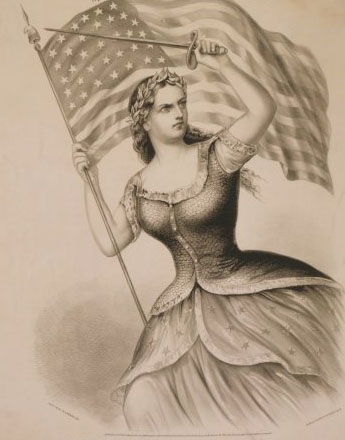
From the PBS series The Mexican American War, "Manifest Destiny: Native American Displacement Amid U.S. Expansion," A Conversation With R. David Edmunds, at the University of Texas at Dallas -- There is an interesting symbolic portrayal of Manifest Destiny that shows "Columbia," the great American angel or woman, floating over the plains. Ahead of her, in the West, is a great darkness populated by wild animals. There are bears and wolves and Indian people, who are fleeing her light. In her wake come farms, villages and homesteads and in the back are cities and railroads. As the figure progresses across the land, the light of civilization dispels the darkness of ignorance and barbarity.
In this painting, Native American people are portrayed along with the animals and the darkness. They have to be removed before Columbia can bring the prosperity promised to the United States. It's an interesting portrayal and, I think, very symbolic of the thinking of many Americans during the mid-19th century. (source: PBS)


From the New York Times Opinionator Disunion, on 2 July 2, 2011, "Hail, Columbia!" by Ellen L. Bergg (Disunion follows the Civil War as it unfolded.) -- As Union soldiers went off to war, the national figure most often urging them on in political cartoons and political stump speeches wasn’t Uncle Sam, but Columbia. Forgotten today even as her name adorns universities, rivers and cities across the country, Columbia was America’s response to Britannia, a secular goddess who personified the national spirit. Both Britannia and Columbia were patterned after other goddess figures: Britannia copied Minerva’s helmet, for example, and both symbols frequently identified themselves with the Goddess of Liberty by displaying or wearing the “liberty cap.”

Columbia and the Revolution
From these roots in classical symbolism, Columbia’s identity gradually solidified during the first half of the 19th century. In these early days, Columbia, or her twin, the Goddess of Liberty, rivaled the American eagle in popularity as an emblem of public patriotic proclamation. While Columbia and Liberty remained more or less interchangeable, appearing on everything from weathervanes to tattoos, artists and writers intended Columbia to represent not just one virtue, liberty, but the entirety of American ideals.

Columbia particularly favored appearances in political cartoons, embodying the United States in commentators’ portrayals of international and national conflict and accord; she frequently provided a foil, and a voice of rectitude, for American politicians and presidents. She often appeared with other evolving American national symbols: a number of cartoons in the 1850s and 1860s depict her with the short-lived “Brother Jonathan,” an uncouth Yankee representative of the common people, whose attributes were later incorporated into our now-familiar symbol of federal government authority, Uncle Sam.
As the country hurtled toward conflict in 1860, Northern political cartoonists relied increasingly on Columbia as an artistic device to represent the United States. While Columbia had often been depicted as emotionally flat — smiling benignantly or weeping for a fallen hero — the prospect of war and the beginning of hostilities infused her with fire in defense of the Union. She increasingly appeared in cartoons as an active, powerful force, sometimes even as a warrior, embodying Northern hopes for victory.
Since Columbia was inexorably tied to the United States but also sacred to the history of the Confederate states, Southerners had a conflicted relationship with the symbol. While visual depictions of Columbia became rare in the South, Southerners continued to embrace her in other ways. Take the now nearly forgotten patriotic song “Hail Columbia,” the unofficial national anthem almost since its debut in 1796. While some Southerners publicly disowned the song — South Carolina banned both it and “Yankee Doodle” soon after secession — others declared “an equal right” to it. Confederate troops were heard playing the tune, perhaps with alternate lyrics, and responded with unexpected emotion to Northern renditions of it during quiet moments in camp. (“Hail Columbia” retains a tenuous foothold in modern times as the official song of the vice president.)

On the battlefield, too, the name Columbia was often found on soldiers’ lips. Union and Confederate troops alike made a transparent attempt to soften their language with a euphemism that revealed their common ties. As they headed into battle, they roared to their compatriots: “Give ‘em Hail Columbia!” (source: New York Times Opinionator Disunion)
Hail Columbia! the First American National Anthem of the United States of America


No comments:
Post a Comment